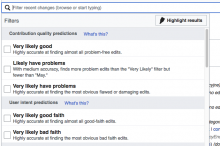The current description of the ORES "Likely" filters is designed to get around the fact that they cover a wide range of precision/recall results—by just describing the recall relative to other filters:
With medium accuracy, finds more problem edits than the “Very Likely” filter but fewer than “May.”
But with the more flexible way we're setting levels now, three wikis (at present) don't have the "May" filters at all. So a new solution is needed that doesn't refer to them. Also, the existing formula is very wordy.
Technical changes
- We will create two "new" "Likely" filters—one in Quality and one in Intent— that have the same names as the current ones and the same threshold assignments. The only change is that these new filters have different description language.
- We'll assign the "new" filters to some wikis and the "old" ones to others. (Strictly as internal names, I'm calling the variations "Low" (for low-ft model) and "High) (high-fit). ) Here are the filter assignments:
- Quality filter assignments:
- Low-fit: en, pt, cs, fa, nl, ru, tr, et, fi, ro, sq, fr
- High-fit wikis: pl, wd, he.
- Intent filter assignments:
- Low-fit: en, pt, cs, fa, nl, ru, tr, et, fi, pl, ro, sq, fr
- High-fit wikis: wd, he.
Language changes
Note that in addition to changing the descriptions of the "Likely" filters, we will also ammend the "Very likely" descriptions, by changing "highly accurate" to "very highly accurate," to help distinguish these from the high-fit "Likely" filters.
Quality filters
[Description text for "Likely have problems"—Low]
With medium accuracy, finds an intermediate fraction of problem edits.
[Description text for "Likely have problems"—High]
With high accuracy, finds most problem edits.
**[Description text for "Very likely have problems"-Both]
Very highly accurate at finding the most obviously flawed or damaging edits.
Intent filters
[Description text for "Likely bad faith"—Low]
With medium accuracy, finds an intermediate fraction of bad-faith edits.
[Description text for "Likely bad faith"—High]
With medium accuracy, finds most bad-faith edits. [yes, "medium" accuracy is correct here.]
**[Description text for "Very likely bad faith"—Both]
Very highly accurate at finding the most obvious bad-faith edits.
